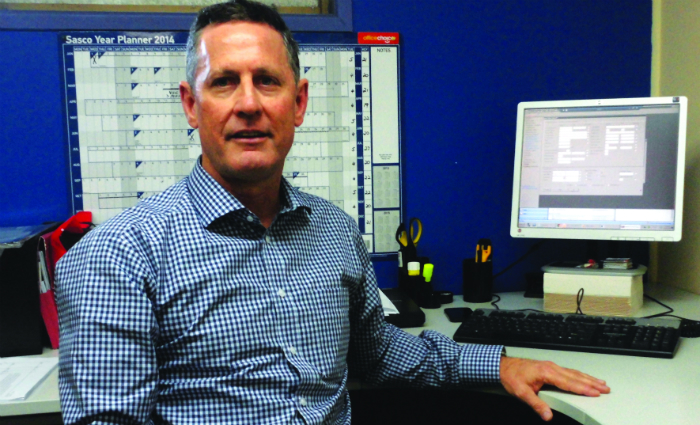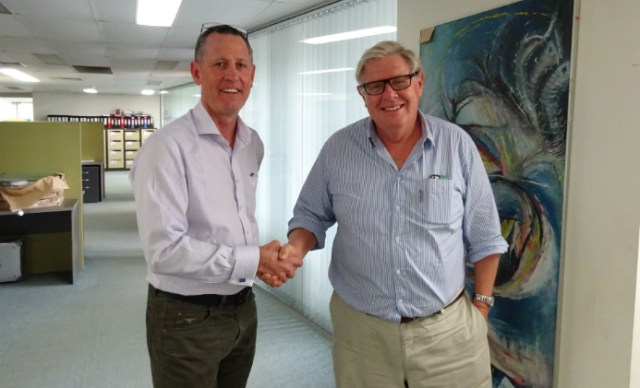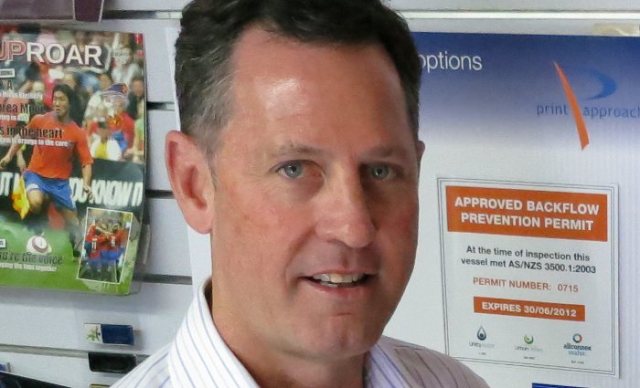
Two years ago Print Approach was a company firmly focused on the big end of town. Despite being located almost half way to the Sunshine Coast, its clients typically consisted of big Brisbane corporate clients, agencies, and print managers, while its presence in the rapidly expanding community along the M1 corridor was non-existent. That all changed after it bought out Nicholson Printers, 20 minutes up the road in Caboolture with a polar opposite client base. The deal netted Print Approach all Nicholson’s equipment, including two Heidelberg GTOs and two Fuji Xerox digital printers, eight new staff and 480 names of small to medium business clients in the local area stretching north towards the Sunshine Coast.
Managing director Tom Eckersley says this massive influx of small clients, combined with the ongoing development of the region, prompted a total realignment of the business, to the point where 50 per cent of its clients today are locally-based SMEs that make up 20 per cent, and growing, of the firm’s revenue. “We have moved our focus to this local market now and we see so much growth opportunity there compared to chasing the big end of town,” he says. “Buying Nicholson has been a huge catalyst to reposition the business towards our local area and brought a reason to look at it in a different way.”
“While we have been here for many years, most of our clients were from Brisbane because when we built this place there wasn’t much infrastructure, but particularly over the last 10 years a lot of business has sprung up – the area has changed dramatically, there is a lot of money being injected into it. It was good to buy a printer that was really founded on serving local business and tap into that overnight.” Eckersley says new businesses opening along the corridor means Print Approach has a growing number of new clients and with few other printers in the area it is a good opportunity for growth. “It is incredibly exciting times,” he says.
Challenges
The transition has not been without its challenges. Eckersley points out that a totally different kind of client requires a different model of service, sales and production, compared to the big clients that had been his company’s core market for so many years. “Their dollar spend is less per business and they have smaller jobs,” he says. “The way you manage 100 customers spending $2000 a year with you compared to one customer spending $200,000 requires a totally different model. We have a bigger account management team than ever before, but we don’t go and see clients as often because you can’t get the return on investment having a foot soldier out there regularly seeing a client that spends $2000-5000 a year with you, it’s unprofitable. However, that has the downside of not finding out one of your clients is a sleeping giant who could be doing a lot more printing if you helped them market their business better, or do not know the services we can provide.”
Eckersley says Print Approach has been able to integrate the two kinds of clients effectively because it profiles each client depending on how much it is likely to spend and shift the appropriate resources in the right balance. This also helps the printer grow smaller customers into higher-spending profiles by helping them grow their business. “We are providing them with tools to increase revenue or conduct their business better, whether that be a commoditised item like printing, or advice and support or another type of service, he says.” We didn’t need that with corporate clients because they have whole departments focused on business development, so it is a different conversation.”
Changes to accommodate this have also come in Print Approach’s marketing and sales strategy. It now has a marketing manager who packages that communication and gets the right message out to potential clients about the services available.
The influx of new clients also came in time to offset declining commercial print work coming in from Brisbane. Eckersley says the amount of big corporate, print manager and agency work has dropped because a lot of print managers have adopted broader print buying practices using much more sophisticated procurement systems that match printers to specific jobs. “Five years ago their print suppliers consisted of a network of print suppliers, we would meet and go to lunch with them, but that has changed dramatically – their supply chains have broadened and include more overseas or national-based printers,” he says. “It means we can never rely on their business going forward like we used to and we need to adapt to that changing world.”
He says corporate clients are also using his company less as a primary printer and more of an emergency or specialist supplier. “We now have to really question whether we go out and chase a big corporate tender because we know that so many others will be targeting it, so we have to think of what value we can bring to it. We are applying for less of those than ever before,” he says. The dramatic decline in demand for Scratchie tickets, formerly one of Print Approach’s key specialty items, has also contributed to the move away from city clients.
Repositioning the business has created new opportunities, however, and coincides with efforts to shake up the product mix and target higher margin areas outside traditional print. After buying Nicholson, and the 400-strong client list of liquidated Brisbane firm ABC Printing, Eckersley’s goal was to double turnover to $4m by June 2014. He says this has been accomplished through exploring a variety of new markets, and retaining about 18 per cent of ABC’s $4.5m business, which was in line with expectations.
He says the past financial year is the best for a long time. Staff numbers have remained consistent since taking on the
eight employees from Nicholson, but the company has added two apprentices through the Future Print program, one in digital print, mostly to help run multiple HP Indigos, and another in print finishing.
Eckersley has moved all production from the Nicholson site to Print Approach’s facility in Narangba and kept the building for the time being as a sales and warehouse facility. “It made sense to consolidate the manufacturing into one building, especially as they are only 20 minutes apart,” he says. He says the building is now a bit cramped for space so work has just begun on a 140sqm extension on the north-east end of the 1200sqm building. This will consolidate digital and prepress into one area giving better efficiency by putting the team all in one place. The next phase is to add 250sqm of warehouse space so he can move everything from Nicholson in.
Another goal for last June was to slash the share of traditional print from 90 per cent to 60 per cent, with investment in wide format, digital, design, and peripheral services, to become a full solution provider, not just a printer. “I think we are seeing a trend in the market to shorter print runs and we are transitioning more and more into digital, but I think that change has slowed and the mix of work on each platform, from what we are seeing, is stabilising,” he says.
Eckersley says an important consideration when diversifying the business was to be realistic about what Print Approach was actually capable of doing. This required a lot of trial and error to determine what was profitable and competitive, and what was best left to other printers with specialist skills. The company quickly discovered it was best to to stick to small-run boutique marketing type digital work and avoid longer runs of bigger printers, where the competition is too intense.
Knowing your limitations was especially true for the wide format market, where Print Approach discovered there are some things it should provide in-house and some that should be outsourced. Finding that balance took six months of trial and error. Eckersley says recent equipment trends mean high-end work is best done by a dedicated wide format trade printer and Print Approach will stay out of that space. “The disparity between the top end pieces of equipment and the general equipment has widened,” he says. “The best printers have become bigger, better, faster, and superior, but they come at a cost – the latest full-spec HP Latex will set you back more than $460,000 and it needs to run two shifts a day at least five days a week, and that is what only a trade printer can really do. While we want to explore new opportunities, it’s important to keep in check what is realistic, and what can be done to earn a dollar without compromising quality and service. We don’t want to stretch to try to be all things to all people.”
He says big signage jobs, and especially the assembly of them, is outsourced to Signs Australia, who he says are experts in that field. “We can’t get that experience overnight, the only way would be if we acquired a specialist signs business,” he says.
While there were some failures there have also been some unexpected success stories. Eckersley says growth in pick and pack and logistics has far exceeded expectations. Some new clients, like an aviation documentation company, wanted to close down their warehouses and instead are paying their print supplier to do manage its documentation instead.
Print Approach built an online ordering system for those clients to send their content in for design, production, and distribution, freeing up the clients to focus on their core business. “It makes a lot of sense for printers to pursue that broader supplier chain to give value adds to clients that save them a lot of money,” he says.
Design work even is more important now because of the number of SME clients the company has gained. While bigger corporate clients do not need as much design work because they have agencies or in-house designers, SMEs often do not have the skills and can’t afford to hire someone. Eckersley says his firm has integrated some of its design staff into account management so they can do both for the clients they service. SMEs from Nicholson are now being introduced to a much wider range of communication because of Print Approach’s wider gamut of services, and these all need slightly different designs.
Another unexpected effect of increased SME business is the rejuvenation of carbonless book work, like DL forms. “We used to do that in great volumes in years gone by but had pretty well stopped doing it three or four years ago because most clients had moved on from it,” Eckersley says. “However, SMEs are still actively using them, so the demand has increased dramatically since we took on so many of those clients at once.”
The success of the Nicholson and ABC acquisitions has Eckersley looking at more in the future as the next business growth strategy. He says, “We made a strategic decision a while ago to grow through acquisitions instead of having multiple sales reps running around on the road and it has worked really well.” He says he is keen to pursue other acquisitions ‘but has to get the right fit’, though it is harder now because more printers are adopting the growth by acquisition strategy. “There are still the same number of sellers, but far more buyers, but we have done four in the past 12 years so I think we have become pretty good at it.”
Comment below to have your say on this story.
If you have a news story or tip-off, get in touch at editorial@sprinter.com.au.
Sign up to the Sprinter newsletter



